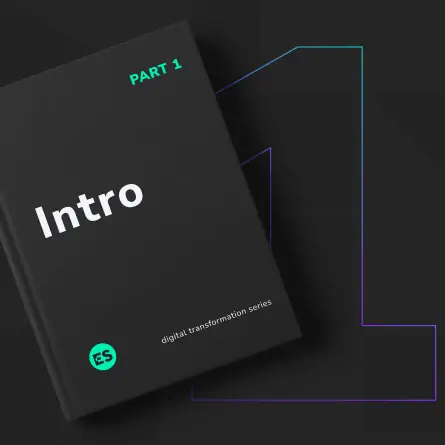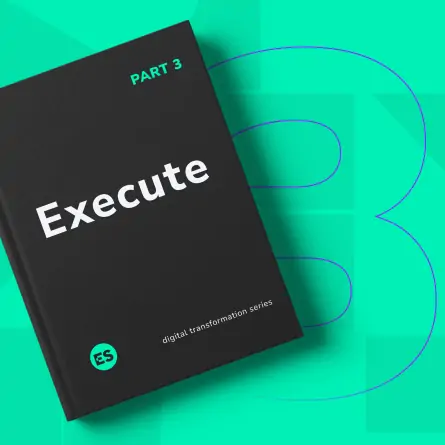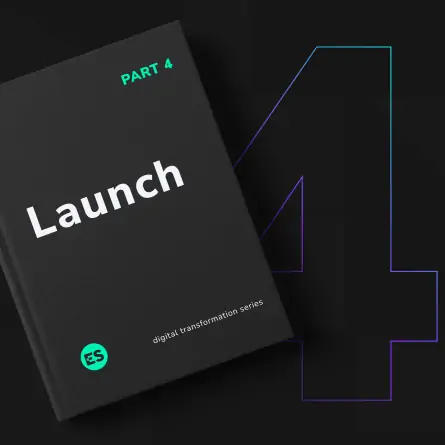Planning, Brand Alignment & Research: The Starting Points for Successful Enterprise Website Redesign
DIGITAL TRANSFORMATION SERIES
PART 2/4
“It does not do to leave a live dragon out of your calculations, if you live near him.”
—J.R.R. Tolkien, The Hobbit
While this quote always makes people chuckle, it’s surprisingly sensible advice that applies equally well in both epic fantasy storytelling and enterprise website redesign: You need to identify the “dragons” in front of you — and plan accordingly for how you’ll deal with them.
Before you begin, make sure you’ve already read:
Part 1 — Introduction to Enterprise Website Redesign
In Part 1 of this blog series, linked above, we explained what enterprise redesigns are all about, and we introduced our four-part approach to successfully executing them:

Here, we’ll take a closer look at the first two project phases — Brand Alignment and Research & Strategy — and explain what you need to do at each of these stages to set your project up for success from the start.
PHASE 1: Brand Alignment
WHAT IT INCLUDES:
✓ Consensus building/organizational alignment
✓ Brand identity
✓ Brand messaging
Is your internal leadership and marketing team aligned on brand strategy, messaging, and value proposition?
There is a common trap that many web redesign projects fall into: moving forward too quickly without accounting for the pre-conditions that must be in place to make the project a success.
As one example, we recently had to temporarily halt a web redesign project for a large enterprise because of a large, unexpected “dragon”: We found that there wasn’t organizational alignment around the broad brand strategy approach. There were outstanding questions about who the primary audiences were, which solutions were going to be prioritized, and how different international business units should be represented.
We were fortunate to identify the issue early, before hundreds of hours had been spent on a direction that the senior leadership would consider misaligned with their vision for the future of the company. So we took a step back, performed a series of alignment workshops with executives and senior leadership, and provided research and SEO insights to inform specific nuances of the strategy. After building consensus around the approach, we were able to move forward.
PHASE 2: Research & Strategy
Define Audience & Users
WHAT IT INCLUDES:
✓ Audience research
✓ Search Pattern Analysis
✓ Analytics & data review
✓ Third-party research & trends
✓ Usability testing
Have you defined your target audience, and do you understand their decision-making factors?
Ultimately, the goal of any enterprise website redesign is to attract visitors, convince them that your product or service is the right fit for them and is superior to competitors, and motivate them to take action.
And in order to create the ideal user journey for your site — from awareness through to conversion — you have to say the right things to the right people at the right time. To do this, you need to understand the decision-making factors of your target audiences so you can effectively craft a content strategy, a process that begins with getting to know your audiences on a deep level.
By conducting surveys and interviews and gathering other data about your audiences, you can ensure that your strategy isn’t driven by an internal echo chamber and based largely on assumptions and anecdotes.
Understanding your audience also means understanding your competitors because you have to be aware of what else your audience is seeing and hearing. This extends beyond the competitors you’re generally aware of and paying attention to; we’ve seen time and again that companies misunderstand who their competitors are on the web. They see certain competitors in their normal day to day, but don’t realize that other competitors are “eating their digital lunch” on the web. That is to say that other competitors who may not offer the same suite of products and services — or may not be as large as your organization — are capturing visitors that land on their website but never find yours.
Define Content Strategy
WHAT IT INCLUDES:
✓ Information architecture
✓ Conversion optimization
✓ Assets requirements planning (videos/imagery)
Have you created an intentional content strategy for your new site — or are you treating it as an afterthought by leaving it to chance?
Content is the lifeblood of your digital strategy: It’s how you’ll influence user decision-making, drive conversions, and maintain your search engine positioning. For that reason, your content strategy needs to be insights-based and outcome-focused.
You’ll want to start by building an understanding of your audience through audience research, identifying their decision criteria, and crafting content that speaks directly to them at key points in their decision cycle.
You can gain these insights through:
- Analytics and search behavior / SEO research
- Quantitative market research
- Qualitative research, such as surveys, focus groups, etc.
Create User Personas
User personas are profiles of people who represent each of your audience segments and outline their needs, expectations, and browsing behavior. User personas establish a very personal look at the people who make up your audience, and they can help you make better decisions regarding your content and user experience.
Establish Typical User Journeys
User journeys provide a visual representation of the sequence of content that different user personas will encounter as they move through your site. The user journey establishes how the site will actually meet the needs of our various user personas, by detailing which content they will be presented with at each phase of their journey through the site.
Lay Out a Messaging Map
For each of your key audience groups, solutions, or product lines, a messaging map can be used to outline how to organize your content to influence decision-making and provide maximum user value.
Why It’s Important to Get Prescriptive About Your Content
Whenever possible, you’ll want to create content prescriptions, which are page-level recommendations for the content and structure of key pages on your site. They provide specific direction for anyone who is creating copy, and ensure that the final version of the page is based directly on the above content recommendations and insights.
Prescriptions include:
- The relevant content components/assets to be utilized on the page (e.g., introductory text, headings, bulleted lists, accordions, photo galleries), and in what order they should be presented;
- A list of page headings;
- Page title and meta tags;
- Keywords and phrases to incorporate into content;
- Specific guidance for copywriters/content creators to follow when crafting the new page;
- Recommendations for content density and length.
Other Important Planning Considerations to Keep in Mind
Commit the Right Amount of People and Time to the Process
When clients ask, “What’s the best thing we can do to ensure success on this project?”, our first answer is always: Make sure the primary point of contact isn’t managing the web redesign on top of their existing 40-hour work week.
We certainly want to reduce the burden on our clients, and we’ve developed processes and methods to help move things forward in the most efficient way possible. But there are many decision points throughout the process that require buy in from internal stakeholders and involvement from the project team, so it’s important that they have the time in their schedules to commit to the project. Without collaboration and consistent communication, we are operating in a “black box,” which can result in mismanaged expectations and unwanted outcomes.
Next up — in Part 3 of our Digital Transformation Series — we’ll dive into executing your enterprise redesign project, discuss the hidden realities of the Design & Build phase, and help you avoid potential pitfalls along the way.
Budget for All the Things
There are a lot of budgeting nuances baked into large-scale strategy, design, and implementation projects. In order to be realistic, your budget will need to take the following into account:
- Review the list of items presented in our Enterprise Redesign Checklist. Is every task that will be outsourced accounted for? If not, are you certain your team can handle those duties internally?
- How much time is allocated in the budget for what we call the “connective tissue” of the project: scheduled & impromptu meetings, feedback & revision cycles, stakeholder scheduling, leadership meetings, etc.? While these line items don’t necessarily align with a particular deliverable, they have to be accounted for in the budget.
- How much buffer is included? It’s generally high risk for both agency and client to work against a fixed-bid number, though it is possible. However, you should budget for at least 20% overage on large projects against the initial estimate — and that’s assuming the initial estimate is thoughtful and thorough.
How Eastern Standard Can Help
Enterprise website redesign projects are massive undertakings that take a significant level of expertise to manage effectively. If you need help better understanding any of the concepts presented here, or would like to discuss the specific needs of your own organization, please reach out to start a conversation today.
Don’t Miss the Rest of the Digital Transformation Series
Q&A
What is brand alignment in enterprise website redesign?
Brand alignment ensures internal leadership and marketing teams agree on brand strategy, messaging, and value proposition before redesign begins. Without organizational consensus on primary audiences, prioritized solutions, and business unit representation, projects risk spending hundreds of hours on directions that senior leadership will reject as misaligned with company vision.
Why is competitor analysis important for website redesign content strategy?
Understanding competitors reveals what else your audience sees and hears when making decisions. Companies often misunderstand their true web competitors, focusing on familiar industry players while other organizations capture visitors who never find your site. Digital competitors may differ significantly from those encountered in day-to-day business operations.
What are content prescriptions in website planning?
Content prescriptions are page-level recommendations defining content and structure for key pages. They specify content components and their order, page headings, title tags and meta information, keywords to incorporate, guidance for copywriters, and recommendations for content density and length. This ensures pages are based on strategic insights rather than created ad hoc.
How should organizations budget for enterprise website redesign?
Realistic budgets must account for all outsourced tasks from the enterprise redesign checklist, connective tissue activities like meetings and revision cycles that do not align with specific deliverables, and at least 20% buffer against initial estimates. Project contacts should not manage redesigns on top of existing full-time responsibilities.
Eastern Standard guides enterprise organizations through successful website redesigns. Our website design team delivers strategic digital transformations. Contact us about your redesign project.



